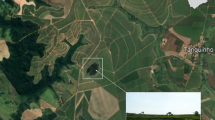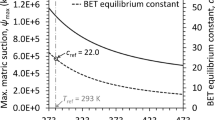Abstract
Wetlands are sensitive, easily disturbed, and globally important ecosystems which face lots of threats, such as global climate change and local human activities. Those might result in the degradation of wetlands. The relationship between hydrological connectivity and the degradation of wetlands has gained prominence among researchers as a simple way to quickly evaluate the degradation of wetlands. This metric is responsive to preferential flow, which can, to some extent, indicate hydrological connectivity. To quantify hydrological connectivity at soil column scales, we explored the relationships between soil properties and the strength of preferential flow in samples from a degrading wetland in which Chinese tamarisk (Tamarix chinensis Lour.) grow in the Yellow River Delta. We conducted laboratory solute penetration tests through the undisturbed soil sample columns and analyzed the relationship between the solute penetration test results and preferential flow. We then verified the applicability of the dual-permeability model to predict the results of the solute penetration test. Our results revealed that the discharge rate from the soil columns was the highest in samples from 20 to 40 cm soil depth and that the flow of discharge concentration remained stable for a long time before increasing rapidly, which exhibited rich medium porosity and macroporosity. We associated this with some improvement in hydrological connectivity, which was also consistent with our dual-permeability simulation results. In the future experimental operation, we can preliminarily predict the hydrological connectivity and preferential flow intensity of soil column by using the dual-permeability model with the discharge data of solute penetration test, which can help us know quickly to what extent are wetlands degraded.




Similar content being viewed by others
References
Boswell JS, Olyphant GA (2007) Modeling the hydrologic response of groundwater dominated wetlands to transient boundary conditions: implications for wetland restoration. J Hydrol 332:467–476. https://doi.org/10.1016/j.jhydrol.2006.08.004
Coppola A, Gerke HH, Comegna A, Basile A, Comegna V (2012) Dual-permeability model for flow in shrinking soil with dominant horizontal deformation. Water Resour Res 48:1189. https://doi.org/10.1029/2011WR011376
Covino T (2017) Hydrologic connectivity as a framework for understanding biogeochemical flux through watersheds and along fluvial networks. Geomorphology 277:133–144. https://doi.org/10.1016/j.geomorph.2016.09.030
De Boever M, Gabriels D, Ouessar M, Cornelis W (2016) Influence of Acacia trees on near-surface soil hydraulic properties in Arid Tunisia. Land Degrad Dev 27:1805–1812. https://doi.org/10.1002/ldr.2302
Dušek J, Vogel T, Lichner L’u, Čipáková A, Dohnal M (2006) Simulated cadmium transport in macroporous soil during heavy rainstorm using dual-permeability approach. Biologia 61:96. https://doi.org/10.2478/s11756-006-0167-9
Emanuel RE, Hazen AG, McGlynn BL, Jencso KG (2014) Vegetation and topographic influences on the connectivity of shallow groundwater between hillslopes and streams. Ecohydrology 7:887–895. https://doi.org/10.1002/eco.1409
Gerke HH, Maximilian Köhne J (2004) Dual-permeability modeling of preferential bromide leaching from a tile-drained glacial till agricultural field. J Hydrol 289:239–257. https://doi.org/10.1016/j.jhydrol.2003.11.019
Han E, Kautz T, Perkons U, Lüsebrink M, Pude R, Köpke U (2015) Quantification of soil biopore density after perennial fodder cropping. Plant Soil 394:73–85. https://doi.org/10.1007/s11104-015-2488-3
Hendrickx JMH, Flury M (2001) Uniform and preferential flow mechanisms in the vadose zone. In: Conceptual models of flow and transport in the fractured vadose zone. National Research Council, National Academy Press, Washington, DC
Hu X, Li Z-C, Li X-Y, Liu L-y (2016) Quantification of soil macropores under alpine vegetation using computed tomography in the Qinghai Lake Watershed, NE Qinghai-Tibet Plateau. Geoderma 264:244–251. https://doi.org/10.1016/j.geoderma.2015.11.001
Jencso KG, McGlynn BL, Gooseff MN, Bencala KE, Wondzell SM (2010) Hillslope hydrologic connectivity controls riparian groundwater turnover: implications of catchment structure for riparian buffering and stream water sources. Water Resour Res 46:323. https://doi.org/10.1029/2009WR008818
Karim F, Kinsey-Henderson A, Wallace J, Arthington AH, Pearson RG (2012) Modelling wetland connectivity during overbank flooding in a tropical floodplain in north Queensland, Australia. Hydrol Process 26:2710–2723. https://doi.org/10.1002/hyp.8364
Kim J, Mohanty BP (2017) A physically based hydrological connectivity algorithm for describing spatial patterns of soil moisture in the unsaturated zone. J Geophys Res Atmos 122:2096–2114. https://doi.org/10.1002/2016JD025591
Kindlmann P, Burel F (2008) Connectivity measures: a review. Landscape Ecol 45:41. https://doi.org/10.1007/s10980-008-9245-4
Kodesová R, Vignozzi N, Rohosková M, Hájková T, Kocárek M, Pagliai M, Kozák J, Simånek J (2009) Impact of varying soil structure on transport processes in different diagnostic horizons of three soil types. J Contam Hydrol 104:107–125. https://doi.org/10.1016/j.jconhyd.2008.10.008
Larsbo M, Koestel J, Jarvis N (2014) Relations between macropore network characteristics and the degree of preferential solute transport. Hydrol Earth Syst Sci 18:5255–5269. https://doi.org/10.5194/hess-18-5255-2014
López-Vicente M, Sun X, Onda Y, Kato H, Gomi T, Hiraoka M (2017) Effect of tree thinning and skidding trails on hydrological connectivity in two Japanese forest catchments. Geomorphology 292:104–114. https://doi.org/10.1016/j.geomorph.2017.05.006
Ma Z, Zhang M, Xiao R, Cui Y, Yu F (2017) Changes in soil microbial biomass and community composition in coastal wetlands affected by restoration projects in a Chinese delta. Geoderma 289:124–134. https://doi.org/10.1016/j.geoderma.2016.11.037
McDonough OT, Lang MW, Hosen JD, Palmer MA (2015) Surface hydrologic connectivity between delmarva bay wetlands and nearby streams along a gradient of agricultural alteration. Wetlands 35:41–53. https://doi.org/10.1007/s13157-014-0591-5
Müller K, Katuwal S, Young I, McLeod M, Moldrup P, de Jonge LW, Clothier B (2018) Characterising and linking X-ray CT derived macroporosity parameters to infiltration in soils with contrasting structures. Geoderma 313:82–91. https://doi.org/10.1016/j.geoderma.2017.10.020
Nimmo JR (2012) Preferential flow occurs in unsaturated conditions. Hydrol Process 26:786–789. https://doi.org/10.1002/hyp.8380
Nosalewicz A, Lipiec J (2014) The effect of compacted soil layers on vertical root distribution and water uptake by wheat. Plant Soil 375:229–240. https://doi.org/10.1007/s11104-013-1961-0
Poesen J, lngelnm-Sanchez F (1992) Runoff and sediment yield from topsoils with different porosity as affected by rock fragment cover and position. CATENA 19:451–474. https://doi.org/10.1016/0341-8162(92)90044-C
Poulter B, Goodall JL, Halpin PN (2008) Applications of network analysis for adaptive management of artificial drainage systems in landscapes vulnerable to sea level rise. J Hydrol 357:207–217. https://doi.org/10.1016/j.jhydrol.2008.05.022
Pringle C (2003) What is hydrologic connectivity and why is it ecologically important? Hydrol Process 17:2685–2689. https://doi.org/10.1002/hyp.5145
Ray C, Vogel T, Dusek J (2004) Modeling depth-variant and domain-specific sorption and biodegradation in dual-permeability media. J Contam Hydrol 70:63–87. https://doi.org/10.1016/j.jconhyd.2003.08.009
Richards K (1993) ‘real’ geomorphology revisited. EARTH SURFACE PROCESSES AND LANDFORMS 19:277–281. https://doi.org/10.1002/esp.3290190310
Seilheimer TS, Wei A, Chow-Fraser P, Eyles N (2007) Impact of urbanization on the water quality, fish habitat, and fish community of a Lake Ontario marsh, Frenchman’s Bay. Urban Ecosyst 10:299–319. https://doi.org/10.1007/s11252-007-0028-5
Shao W, Bogaard T, Bakker M, Berti M (2016) The influence of preferential flow on pressure propagation and landslide triggering of the Rocca Pitigliana landslide. J Hydrol 543:360–372. https://doi.org/10.1016/j.jhydrol.2016.10.015
Singh YP, Nayak AK, Sharma DK, Singh G, Mishra VK, Singh D (2015) Evaluation of jatropha curcas genotypes for rehabilitation of degraded sodic lands. Land Degrad Dev 26:510–520. https://doi.org/10.1002/ldr.2398
U.S. Environmental Protection Agency (1992) Monitoring Guidance for the National Estuary Program. Office of Water
Wang Y, Bradford SA, Šimånek J (2014) Estimation and upscaling of dual-permeability model parameters for the transport of E. coli D21g in soils with preferential flow. J Contam Hydrol 159:57–66. https://doi.org/10.1016/j.jconhyd.2014.01.009
Wang Y, Fan J, Cao L, Liang Y (2016) Infiltration and runoff generation under various cropping patterns in the red soil region of China. Land Degrad Dev 27:83–91. https://doi.org/10.1002/ldr.2460
Woo M-k, Young KL (2003) Hydrogeomorphology of patchy wetlands in the high arctic, polar desert environment. https://doi.org/10.1672/8-20
Wood EF, Lettenmaier DP, Zartarian VG (1992) A landsurface hydrology parameterization with subgrid variability for general circulation models. J Geophys Res 97:2717–2728. https://doi.org/10.1029/91JD01786
Yagüe MR, Domingo-Olivé F, Bosch-Serra ÀD, Poch RM, Boixadera J (2016) Dairy cattle manure effects on soil quality: porosity, earthworms, aggregates and soil organic carbon fractions. Land Degrad Develop 27:1753–1762. https://doi.org/10.1002/ldr.2477
Zhang Y, Niu J, Yu X, Zhu W, Du X (2015a) Effects of fine root length density and root biomass on soil preferential flow in forest ecosystems. Forest Syst 24:12. https://doi.org/10.5424/fs/2015241-06048
Zhang Y, Niu J, Zhu W, Du X, Li J (2015b) Effects of plant roots on soil preferential pathways and soil matrix in forest ecosystems. J For Res 26:397–404. https://doi.org/10.1007/s11676-015-0023-2
Zhang Y, Zhang M, Niu J, Zheng H (2016) The preferential flow of soil: a widespread phenomenon in pedological perspectives. Eurasian Soil Sc 49:661–672. https://doi.org/10.1134/S1064229316060120
Zhang Y, Niu J, Zhang M, Xiao Z, Zhu W (2017) Interaction between plant roots and soil water flow in response to preferential flow paths in Northern China. Land Degrad Dev 28:648–663. https://doi.org/10.1002/ldr.2592
Acknowledgements
This research was supported by the National Natural Science Foundation of China (41771547).
Author information
Authors and Affiliations
Corresponding authors
Additional information
Publisher's Note
Springer Nature remains neutral with regard to jurisdictional claims in published maps and institutional affiliations.
Rights and permissions
About this article
Cite this article
Liyi, D., Yinghu, Z., Zhenming, Z. et al. Hydrological connectivity assessment based on solute penetration. Stoch Environ Res Risk Assess 34, 909–919 (2020). https://doi.org/10.1007/s00477-020-01805-0
Published:
Issue Date:
DOI: https://doi.org/10.1007/s00477-020-01805-0




